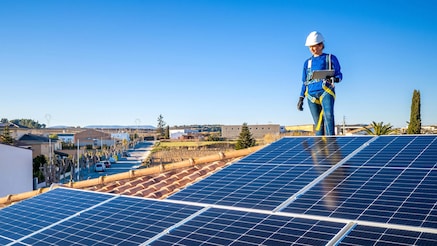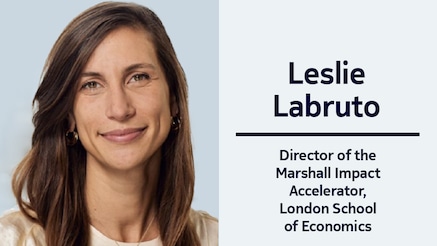The evolution of the microgrid
Real Conversations podcast | S5 E1 | January 5, 2023

Biography
Dr. Hillig is the founder and managing director of THEnergy, a boutique consultancy established in 2013 focusing on microgrids, mini-grids and off-grid renewable energy.
Microgrids are evolving, but sometimes a renewable power source isn't always the solution. Dr. Thomas Hillig of THEnergy explains the business case for campuses, companies, and communities to make the move to this next generation technology powered by AI and 5G
Below is a transcript of this podcast. Some parts have been edited for clarity.
Michael Hainsworth: Not every corporate campus, mining operation, or community needs a micro grid. Who needs a reliable, independent supply of electricity? And why renewable energy microgrids are not always the go-to solution? Dr. Thomas Hillig advises companies on sustainability, renewables, and when microgrids make sense at THEnergy. And like many of the people we've spoken to, his past helps inform the future as he made the leap from the old world of big electricity into the 21st century.
Thomas Hillig: I have a background in environmental services for conventional energy for gas fired power plants, for coal fired power plants, filter equipment, and so on. After that, I was already in the renewable energy sector, but I was working in Photovoltaic (PV) module sales and I also was responsible for PV projects, typical stuff somewhere in Europe or the US, free field installations. After that, I wanted to start something on my own and I wanted to rely on stable framework conditions, so typically not on regularly changing policies. In standard renewables, basically, you had a good year in Spain. After that, a good year in the German market. After that, a good year in Italy and the UK. But I decided to do something really strange, actually two pretty big contrasts. Renewables on the one hand, but for the mining industry for remote mining, where you have large amounts of energy consumption, and microgrids, because you have to do the mining where the resources are and not where electricity is the cheapest.
MH: A microgrid isn't just the same as a regular grid, only smaller. Explain the significance of a microgrid being an island.
TH: Microgrids allow, under certain circumstances, for an islanded power generation. In the end, you decouple from the national grid in a microgrid, or you in some cases are not connected at all, this is the second option. And then you generate electricity locally and consume it also locally. It does not have to be 100% of the time, you could be ... A village could be connected to the national grid, but under certain circumstances, for example, if there are hurricanes, if there are certain wildfire conditions, it could make sense to decouple a certain section of the grid from the national grid and this is what a microgrid is in the end.
MH: We talk a lot about the issue in North America being that we have an aging infrastructure for electricity generation and transmission and that this may be a solution as well. But to your point, you could have this in a faraway region that doesn't have access to transmission lines that exist. When we think of the technology that underpins a modern microgrid, I suppose we need to look at both the software and the hardware. What role does artificial intelligence and algorithms play in software?
TH: On the software side, in the end, you want to match renewable energy or energy generation in total with consumption. Demand and supply should be matched in an optimized way. In a typical microgrid, at least in sophisticated ones, you have plenty of sensors, input data, AI algorithms and machine learning to help optimize this matching of demand and supply.
MH: Is this the kind of thing that you need to bring inside help for? It doesn't sound like you can just go to your local electronics store and buy an AI that helps you with a microgrid.
TH: Microgrid solutions are more something for communities. If you have your own PV panel or array on the roof, you wouldn't talk about a microgrid. It's more for villages and it is indeed a more sophisticated solution. Absolutely.
MH: What about control technology? When it comes to the hardware, are we talking about IoT, the internet of things?
TH: The internet of things can play an important role. There are different degrees of sophistication in microgrids. For example, at remote sites in Africa where microgrids could bring electricity power for the first time to people that did not have access to power before, there typically ... You won't have microgrids that are so sophisticated. If we think about what you mentioned before, about improving aging infrastructure in the US, this is absolutely an IoT topic.
MH: IoT and 5G are very complimentary technologies. What role does the wireless technology and the service provider for it play in a modern microgrid?
TH: Microgrids are very much about collecting tons of data. One of the typical expressions is, if you want to optimize a microgrid, you have to get through a whole lake of data. To collect this data, some of this data is in stable environments, some is also moving, some is very centralized directly at the grid, sometimes you have to go a little bit beyond the borders of the microgrid. In the end of connecting endless amounts of data and sensors to the central control unit, 5G is an ideal fit.
MH: To your point, it's not just outfitting regions in Africa that don't have access to electricity right now, talking about communities, but also campuses. If I understand correctly, Siemens has a microgrid in Vienna?
TH: Absolutely, yes. They have a microgrid in Vienna. There, the capacity of their power connection was not big enough for the challenges of providing electromobility (e-mobility) solutions for their employees. So, they decided to generate more electricity on site to have a microgrid. But I have to admit, they have a little bit different definition of microgrid, whereas I think 95% of people would stick to my definition. However, here in this case we have the definition, that you have to control the main power parameters on site. In the end, this means they cannot run the microgrid in an islanded mode, but they could avoid upgrading the grid connection by producing more electricity directly on site at the campus.
MH: And when we expand out the idea of incorporating 5G in IoT down the road, I can imagine when we think about smart cities and things of that nature, you've got electric cars that require electricity, and therefore, knowing how much consumption they're taking in from the grid would be a critical component to feeding into that data lake as you point out.
TH: Absolutely. Microgrids and e-mobility, as I mentioned in Vienna. So there, the approach is for employees. While they charge their vehicles during their working time, during the daytime, the driving information; which service technician typically goes how far? Or what is the load level when he typically returns from his trip? What kind of car does he have? All this information would be part of the data lake and would be used to optimize the microgrid.
MH: That's interesting. So, it's not just a far future kind of next generation microgrid in smart city type technology, it's something that we're using right now.
TH: Absolutely.
MH: You've pointed out that there are quite a few views on just what a microgrid is and I suppose there are expectations that it's all renewable energy?
TH: I think many people refer to microgrids these days as a buzzword and think that it is this 'Swiss Army knife' of the energy transition. If you really stick to the original definition, probably it is not so. Most of the microgrids that are out there are, in the end, small diesel gensets, or also bigger diesel gensets. And as the name suggests, diesel gensets are not renewable. At least 99% of the diesel that is used, apart from some biodiesel maybe. But the challenge then is to decarbonize also those microgrids that are out there today, for example, in remote mining or also neighborhood diesel gensets in remote Africa somewhere. To make them more renewable, to run them on renewable energy, gradually replacing diesel consumption or heavy fuel oil consumption, by renewable energy such as solar and wind energy.
MH: When it comes to renewable energy though, what's the state of battery energy storage?
TH: Battery energy storage is an ideal fit if you have a solar array in a shaded area and you have in the background also a conventional generator running, so you can switch off the battery, as a bridge to back up, that allows for switching off the conventional generator during the day. In the end, they are great to improve certain power parameters, to make the energy generation more stable.
Then the next step would be to rely on types of batteries, so-called long-duration energy storage systems. Here then the focus would also be to rely on renewable energy, or fluctuating energy sources during the nighttime. What is even more challenging during seasonal differences, for example, if you have one week without any sun or wind. Because they also rely on renewables. There are flagship projects ongoing, but this is not state-of-the-art today.
MH: Do I understand this correctly? The most well-known sort of battery energy storage technology right now for a microgrid is essentially the same technology as what we've got in our smartphones?
TH: A little bit bigger, but yes, it's lithium-ion batteries. If we talk about long duration energy storage, then names like Redox Flow Batteries (RFB) would come into play. Also, hydrogen as an energy storage carrier.
MH: How does hydrogen work? Because it was always my assumption that hydrogen was a power generation technology, not a power storage technology.
TH: Typically, you convert wind energy and solar energy into hydrogen, then you can store it or you can use it also in industrial processors. For example, in the steel industry, in the glass industry, you can use it for heating, but you can also reconvert it into electricity. If you convert electricity, renewable energy, into hydrogen and reconvert it later into electricity, it is an energy storage medium.
MH: Oh, that's fascinating. Because as I say, the assumption would be that you would create hydrogen, store it, and then use it to generate electricity. But how are you going to generate that hydrogen in the first place? You could use renewable sources to pull the hydrogen out of, I guess, the air and out of systems because it's one of the most prevalent elements in the universe.
TH: Actually, hydrogen, or if you talk about green hydrogen, is generated mainly, or the main input is water. And then you need huge amounts of energy. And if we talk about green energy, it is then renewables, so wind or solar energy to convert the water into hydrogen. There's also a natural hydrogen, but that is typically not really used for power generation.
MH: Does the visibility of renewable energy help sell a microgrid?
TH: Absolutely. I have a nice example. I talked to a safari lodge operator, and they said first they were trying to hide away their solar power plants, they had a remote microgrid at a safari lodge, and then they even did tours because they saw that people actually liked that the microgrid was powered by renewables, that the lodge was powered by renewables. And it was even a driver then for further microgrids at different safari lodges and not to hide them so much away.
If we talk about communities, for example in Europe or in the US, the situation is very similar. In Germany there's a big "not in my backyard" issue, especially with wind power. But if people can invest in local power generation, and if they know, for example, in the upcoming winter, the wind turbines that are just built next door would improve their power supply situations so that they are in a better position when there is a power shortage, for example, in Germany, I think that would help. The pure wind turbine itself, where there is a huge tower and turbine turning, probably does not help too much.
MH: I was fascinated by something you said right at the beginning of this conversation and that is that most microgrids are not primarily powered by renewable energy today, it's a diesel genset somewhere. What's the evolution of the microgrid look like if we're trying to get away from fossil fuels?
TH: The low-hanging fruit is basically ... And the best business case is just to replace a little bit of diesel by renewable energy, without any energy storage. You could inject up to 20% of renewable power, and that does not equate to the same amount of diesel reduction. it would be much lower, depending on the actual application, more like 10% to 5% maybe.
The next step would then be to come up with more sophisticated solutions where you then have advanced control systems, and there you could go well beyond. Next would be to add lithium-ion batteries, about which we talked before. And then the next would be to go to long-duration energy storage systems. The final stage is really to kick out all the backup gensets. However, if you have very seasonal applications, in areas where there's a high probability that you run without solar and wind energy, where you are dealing with very low irradiation and hardly any wind speed over longer time periods, this is a real challenge and could also be very costly.
MH: You mentioned the term "business case". Let's sort of dig into that for a moment. As you point out, there are steps you can take to wean yourself, and wean a microgrid off diesel genset systems. Why not just jump in all in at the very beginning? How do you build that business case to take a microgrid from a diesel-based system to a 100% renewable system?
TH: The different steps, which I just explained, are also a bit associated with different cost levels. The first step is just going in and replacing diesel with bio. In the end, let's assume you could do a five-megawatt plant without any storage. For the next five megawatts, you'll need another five megawatts of solar plus energy storage. The investment cost for the same amount of renewable energy would then be considerably higher if you add storage. And then, if you want to run fully without diesel, then you have to oversize more, and get more storage into the microgrid. This can be really a cost challenge. Achieving that last 5% to 10%, would then be very costly.
If you're starting from scratch, the situation is not much different, because if you go renewable you have to rely, in most places, on solar and on wind power. These two power sources are not stable, they're fluctuating, and there again you'll need energy storage or a flexible energy source like a diesel genset. It could be biodiesel in the end, but if you really want to scale up development, there won't be enough. There would be a shortage of biodiesel if you wanted to balance all microgrids with biodiesel.
MH: And as you've pointed out, this isn't just about building a microgrid for a community, there are enterprises that have a need for a microgrid. It could be a remote mining operation, but maybe it's an automotive factory campus, maybe it's a university campus. How do you make the business case to pull a large enterprise off the national grid and building a microgrid instead? Is it a financial business case or is it more about reducing the carbon footprint and the acknowledgement by industry that they need to do that? How do you make the business case?
TH: That's a good question. I think the main component of the business case is resilience, if you need better quality power than you are getting or than you think you will be getting in the future from the grid. For example, if we talk about hospitals, they already have backup diesel gensets today. If they think, for example, in the US, that there's a higher risk that they have to run large amounts of time on these diesel backup gensets, it could make sense to come up with more local decentralized renewables in the end.
And just putting more renewables in a certain place does not mean that you can really run a certain site fully on these renewables, it is also the aspect of having a grid forming element. Normally, these are conventional power plants, large coal or gas-fired power plants. They form the grid and then you add some renewables. If you go into this islanded mode, something else has to form the grid. And this could be diesel gensets or energy storage. But then you are in a completely different situation. And I have not really fully answered your question...
MH: Well, it's an incredibly complex question!
TH: It is a complex question. For university campuses, just as background information, I think it is just ... They want to show, they want to demonstrate what is technically feasible, probably don't have even a business case, it's playing around a little bit. And there are not too many enterprises who fully go off the grid. I don't know any big factory that was on the grid before, so that you just take off fully off the grid.
MH: So then let me wrap up our time together by asking you this question. What is the most important advice you provide to a client interested in building a microgrid?
TH: I think it's very important to know which problems the microgrid should solve. If it is just about getting cheap electricity, the microgrid is probably not the easiest solution you have at hand. You could also source electricity through corporate and power purchase agreements. If you need power of a higher quality than you are getting from the grid, where in most situations it's very difficult for you to actually convert the power grid, then you might have to do something locally. But be aware... why do you need a microgrid? What are your problems? If you don't have any problem at all today, if you can, for example, source clean energy at acceptable conditions, if your power supply comes at a reasonable price, you probably don't have to think too much about microgrids. If you are somewhere where you have to deal with outages, if your production is really affected, this would then be part of the business case, which could put you in a situation where it might make sense to think about microgrids.


